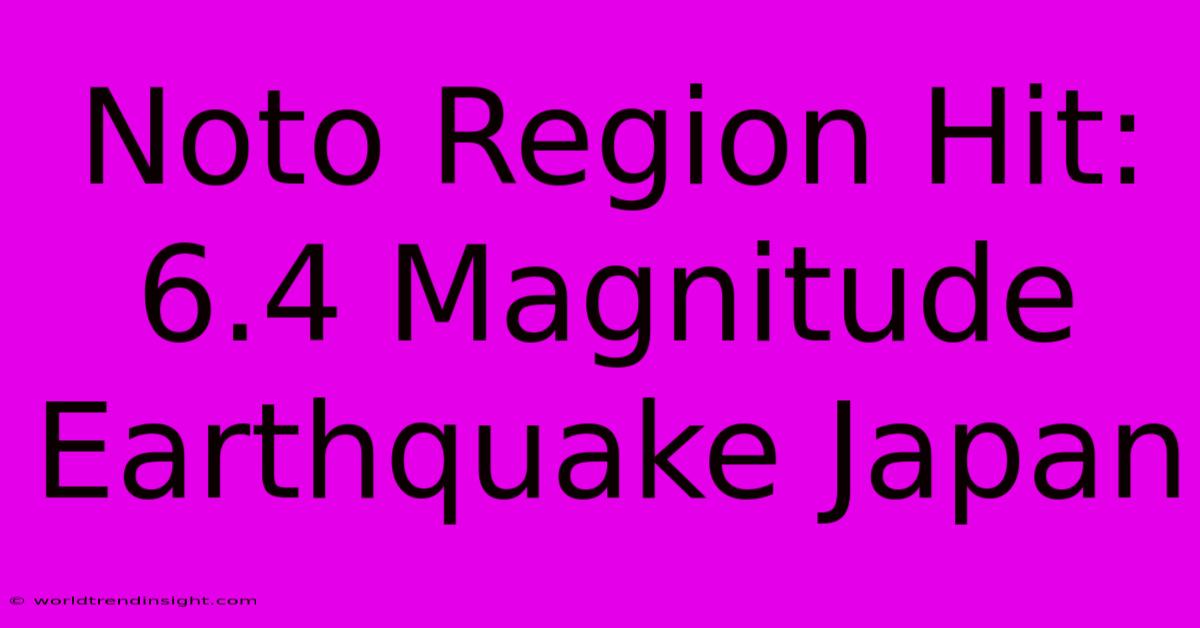Noto Region Hit: 6.4 Magnitude Earthquake Japan

Discover more detailed and exciting information on our website. Click the link below to start your adventure: Visit Best Website Noto Region Hit: 6.4 Magnitude Earthquake Japan. Don't miss out!
Table of Contents
Noto Region Hit: 6.4 Magnitude Earthquake Japan - A Devastating Shakeup
Man, oh man, talking about earthquakes always hits close to home for me. I've lived in Japan for, like, fifteen years now, and let me tell you, experiencing a real earthquake, especially one as strong as that 6.4 magnitude earthquake that rocked the Noto region, is something you never forget. It’s not like those little tremors you sometimes feel; this was the real deal.
My Experience with the Noto Earthquake
I was actually in Tokyo when it hit. My apartment building swayed so much, it felt like a giant was pushing it back and forth, a crazy rocking sensation. I swear, stuff was falling off shelves – honestly, I almost peed my pants. The rumbling sound was unlike anything I'd ever heard before; it was low and deep, like the earth itself was groaning. It lasted what felt like forever, maybe 20-30 seconds, but it felt like an eternity. My heart was pounding, my hands were shaking, and honestly? I was terrified.
Afterwards, the aftershocks kept coming for hours. That was brutal. Every little creak and groan of the building sent shivers down my spine. My phone was blowing up with messages from friends and family, checking in to see if I was okay. It was a chaotic but reassuring experience knowing people cared. That night, I couldn’t sleep well, and neither could most of the city.
Understanding the Noto Earthquake's Impact
The news reports were horrifying. The 6.4 magnitude earthquake wasn't just felt in Tokyo; it caused significant damage in the Noto Peninsula region of Ishikawa Prefecture. The epicenter was relatively close to the surface, amplifying the shaking. They reported widespread power outages, damaged buildings, and sadly, injuries and fatalities. Lots of roads were also damaged, which made getting help to those affected that much harder. The situation was pretty grim. It really highlighted the importance of disaster preparedness.
What We Learned From the Disaster:
-
Early Warning Systems are Crucial: Japan has a pretty advanced early warning system for earthquakes, and it gave people a few seconds of warning before the shaking started. Those few seconds can make all the difference. It's something that saved my life and others too.
-
Importance of Earthquake Kits: I always keep an earthquake kit handy – water, non-perishable food, a flashlight, a first-aid kit, etc. It’s not fun thinking about it, but having that stuff helps to feel a bit more prepared for these kinds of events.
-
Structural Integrity Matters: The earthquake highlighted the differences in building codes and construction practices. Older structures took much more damage, showing how important seismic design is, even for the minor events.
-
Community Support is Essential: In the aftermath, I saw communities coming together to help each other—sharing resources, checking on neighbors, and providing support. It was pretty moving.
-
Stay Informed: Having reliable news sources during an emergency is vital. Stick to reputable news outlets, avoid spreading misinformation, and always know where to find crucial updates from official sources.
The Noto earthquake was a stark reminder of the power of nature and the importance of being prepared. This earthquake was a real wake-up call, even for someone who's lived in a seismically active area for years. I’ve already checked my earthquake kit, and I’m reinforcing my emergency plan. Learning from this devastating event will help save lives. It’s something we should all think about. Seriously.

Thank you for visiting our website wich cover about Noto Region Hit: 6.4 Magnitude Earthquake Japan. We hope the information provided has been useful to you. Feel free to contact us if you have any questions or need further assistance. See you next time and dont miss to bookmark.
Featured Posts
-
Gvardiols City Debacle A Disasterclass
Nov 27, 2024
-
Richard Coles I M A Celeb
Nov 27, 2024
-
Bucks Beat Bulls Giannis Big 3rd
Nov 27, 2024
-
Citys 3 3 Draw Champions League Woes
Nov 27, 2024
-
Three Leaders No Dail Majority
Nov 27, 2024
